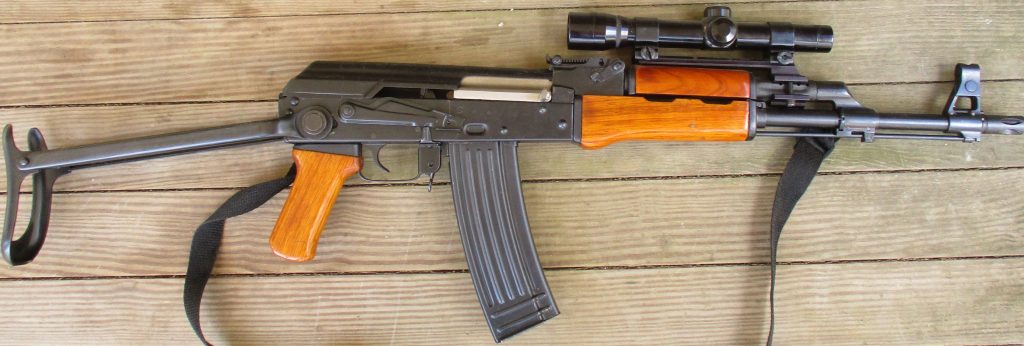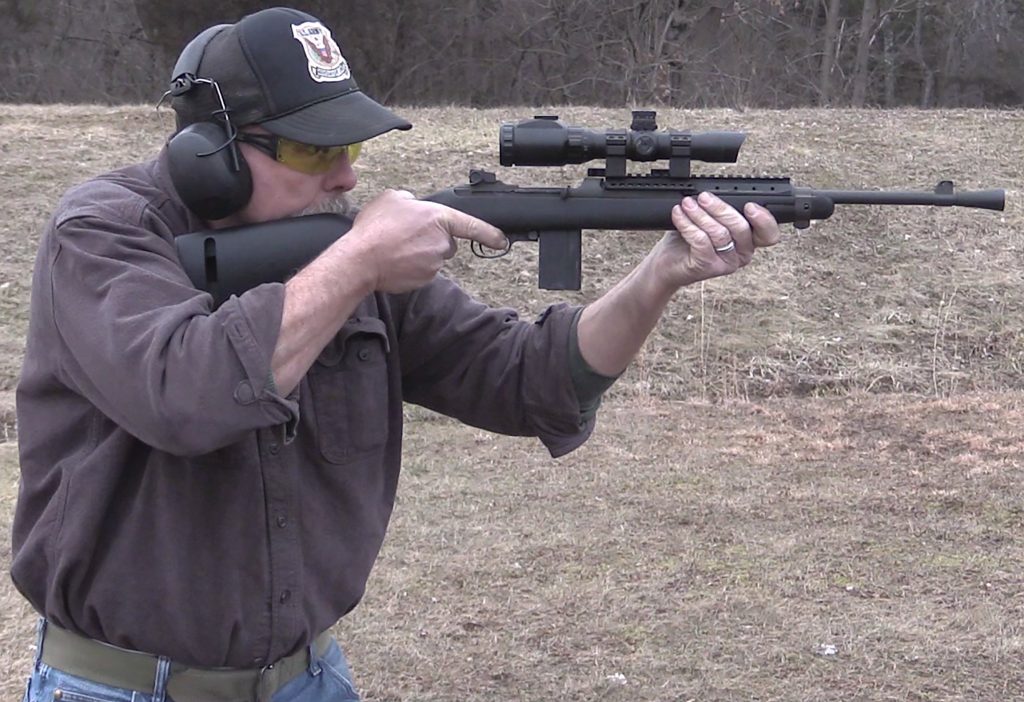By Jim Dickson | Contributing Editor

The modern Scout scoped rifle is defined by its scope and not its rifle’s type or configuration.
If the rifle has a forward mounted scout scope on it that can be used with both eyes open then it is a Scout rifle. Attempts to limit it to clones and near clones of an early bolt-action rifle example have met with failure as semi-auto rifles equipped with Scout scopes have far outclassed the bolt action versions. The sustained rate of fire of a sporting bolt-action rifle without stripper clip guides is no more than that of a single-shot rifle. The ability of a semi-auto with 30-shot magazines to deliver a high rate of fire needs no elaboration here.
When it comes to hitting moving targets the bolt-action scout rifle is an abysmal failure while the semi-auto scout rifle excels at this. You can break clay birds launched from a skeet launcher as consistently with a semi-auto scout rifle as you can with a shotgun. You are doing good to even break one with a bolt-action Scout rifle. The cold hard facts are simply that the bolt action is a 19th century design whose speed of sighting is improved by the Scout scope but it simply cannot compete successfully with modern semi-autos in the 21st century.
This disparity in performance was first brought to the forefront by the noted exhibition shooter Chief AJ, who made his mark in the Guinness Book of World Records by shooting 40,060 wood 2 ½- inch blocks out of the air without a miss with a .22 rifle. Chief AJ developed new methods of teaching shooting with the Scout scope equipped semi-auto.
Camp Games
Using Ruger 10/22 rifles with Scout scopes and 30-round magazines at his rifle training camp, the Menominee Indian Chief starts his students off on a swinging gong target. The student must mount the rifle and fire in one motion because your first sight picture is your best. Once proficient at this they are moved on to moving targets. 15 inch cardboard pizza discs are glued together like a small tire. There is a center cut-out for a clay bird. This assembly is rolled 25 yards in front of the student until they get good at breaking that clay bird. Now the clay bird is launched from a skeet trap at 55 MPH bouncing, rolling, and skipping across the ground. As soon as this is mastered they move on to breaking the clay bird in the air with their scout rifles. It usually takes them about a day and a half to start breaking them as consistently as they can with a shotgun but they do it.

The way they are all breaking these seemingly impossible targets is simple. They aren’t acting like target shooters carefully aligning sights minutely then holding steady and squeezing the trigger slowly. That may work for punching holes in stationary targets on paper but it won’t do for moving targets. The target will be gone before you can get the shot off that way. You don’t have time to get a sight picture and then squeeze the trigger before the target is gone. These shooters are firing as they align the sights with the last shot fired after the target is broken. The brain quickly starts coordinating sight picture and trigger pull so that the clay bird is often broken on the first shot. By firing more than one shot the pressure of everything riding on one shot is off the brain and freed from thinking about it the brain can now relax and just do it. In practice this works very well because you are enlisting the old primitive part of the brain that does things without a lot of thoughts cluttering it up. It’s like the old saying “Keep your eye on the ball” when playing baseball. Don’t think about it. Just do it.
Annie Oakley once said that any hesitation when the moment comes to take the shot will cause a miss. She was right.
This type of shooting is a whole lot more fun and exciting than punching holes in paper targets so the Chief came up with the Running Jackrabbit Match so his students could have a place to use their new skills. This is the only shooting match that is exciting enough to viewers to qualify as a spectator sport. If this was properly promoted as a spectator sport it would do a lot for the pro-gun cause.
A clay bird is the jackrabbit and it is launched from the skeet trap 25 yards in front of the shooter bouncing and skipping along the ground at 55 miles per hour. The scoring grid is 40 yards wide with a hit in the first 20 yards worth 10 points and a hit in the last 20 yards worth 5 points. Any gun except shotguns with birdshot is allowed but the semi-auto scout rifles are the regular winners while the bolt action scout rifles are embarrassing failures at this game.
Every type of semi-auto Scout rifle is used here and every caliber from .22LR to full power military cartridges are used. High capacity magazines are standard. You can see Scout rifles made from Ruger 10/22’s, Mini 14’s, M1 carbines, M1 and M1A’s, AK47’s, SKS’s, G3’s,and more. They all work at this game and they all are fun.
Scout Scope
The Scout scope itself is most often seen in 1X and 2&3/4X versions. The 1X has the widest field of view but I find the 2&3/4X to be the ideal combination of a wide field of view and enough magnification for any shots out to 300 yards. The scout scope is at no disadvantage with conventional scopes out to that range. You should not be shooting game past that range. The German 3 post reticle is preferred because crosshairs blur during rapidfire.
I have always used the Burris scopes on my guns with great satisfaction. In the last year or two I have also used a 1-4X variable Leapers Scout scope on an Inland M1 carbine. It is much larger and heavier but because of that it is very sharp with good light gathering properties. Athlon Optics is going to introduce their own Scout scope in the future. It also promises to be a good one.

I have two Scout rifles that have been priceless on the farm. The first is a semi-auto G3 with a Burris 2.75X scope on it. This gun was not very accurate when I got it so I re-crowned the barrel, put a tighter bolt in, and had the barrel cryogenically treated. The trigger was brought up to Camp Perry National Match standards at Williams Trigger Specialties. This gun now only shoots ¾-inch groups at 100 yards. Never any variation. As a semi-auto it will do everything a bolt-action .308 Scout rifle will do and much more than the bolt-action Scout rifle can ever do.
Improving Accuracy
If you want your gun cryogenically treated I recommend Diversified Cryogenics to do the work. It will greatly improve accuracy, put an end to shots walking as the barrel heats up, and make cleaning as easy as cleaning glass. I wish all guns were cryogenically treated before they left the factory.
The other one is a pre-ban Norinco semi-auto AK47 in 5.56 which has a 2.75X Burris Scout scope on a B-Square mount. This gun shot minute- of-angle groups right out of the box. It’s folding stock makes it very handy and it is murder on coyotes and other farm pests.
The Scout scope is also the best answer for a scope on heavy recoiling rifles. Even the little .375 H&H Magnum has given too many good experienced riflemen the infamous Weatherby eyebrow cut. That can’t happen with the forward mounted Scout scope. It’s foolish to use anything else on a gun with significant recoil. It’s just asking to get hurt.
These powerful rifles are often used on dangerous game where the superior speed of the scout scope can be a real lifesaver. Again, don’t go over 2.75X as finding only hair in your view through a more powerful scope when hunting dangerous game can quickly prove fatal. Grizzly bear in the alders in Alaska is one place where a high magnification conventional scope can get you killed really fast if the bear is coming at you.
Of all the types of scopes out there the scout scope is the most useful in most situations. There is no better rifle scope for use out to 300 yards and it will extend to further range as needed.



